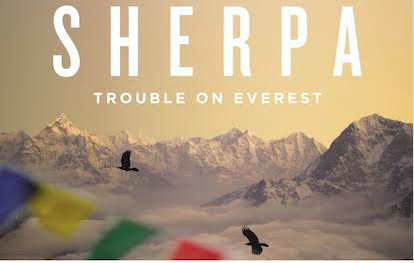by Chanel Zagon | @chanelzagon
On April 18 2014, giant blocks of serac ice on the western spur of Mount Everest came crashing down, killing 16 Nepalese Sherpa guides.
The Sherpas (the name synonymous with mountain guides and denotes their ethnic group) were preparing the South Col route for fee-paying climbers during the climbing season, when the alpine avalanche hit.
Riveting and eye-opening, the documentary Sherpa poignantly captures one of the deadliest disasters in Everest’s history and exposes the immense risk in trekking the tallest mountain in the world.
Director Jennifer Peedom initially made the journey to Nepal in 2014 to document the climbing season and to observe Sherpa leader Phurba Tashi hike to the summit of the mountain for a record 22nd time.
Instead, Peedom witnessed glacial ice plummet from an elevation of 5,800 metres, the seracs weighing over 14 million kilograms.
Hard-hitting and complex, the heart of the film battles an internal conflict between the foreign climbers; who are adamant to continue climbing the trek despite the tragedy, and the Sherpa guides.
Underpaid and exploited, the Sherpas are reluctant to continue climbing in the wake of the devastation and contemplate whether endangering their lives is worth the meager rewards.
“We can’t risk our lives just because foreigners have paid,” one says.
On average, a Sherpa would hike the mountain 30 times a season, often in dark and hazardous conditions, carrying massive quantities of food and equipment for clients.
The film tugs at the audience’s moral conscience, as while the picturesque backdrop of the Himalayan peaks boast breathtaking views, the Sherpas are playing “what is essentially a game of Russian roulette” with their lives.
But to the foreign climbers who have paid a large sum of $100,000 to be on the expedition, the risk and the price are well worth it. Some climbers have even returned for a second or third time, after previous trips have fallen through.
Veteran tour leader Russell Brice remains caught between a rock and a hard place. His clients have invested a fortune in hiking Everest, however if the trek were to continue, the safety and welfare of the Sherpas risks being jeopardized. To continue or cancel, is the question that looms and Peedom succeeds in vividly capturing this upheaval.
While trekking the world’s tallest mountain is tainted with grandeur, audiences are given a glimpse into the stark reality of climbing.
With an average of 600 people reaching the summit each year, the hike to Everest booms as a commercial business, but comes with the greatest cost of all – life.
Visually magnificent and socially conscientious, Sherpa doesn’t hesitate to blatantly reveal the truth behind the prestigious mountain climb.
3 Stars
Sherpa is showing in Australian cinemas now.


